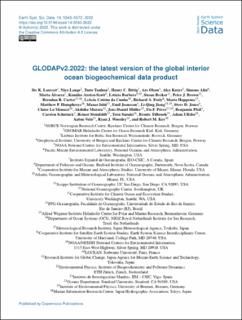| dc.description.abstract | The Global Ocean Data Analysis Project (GLODAP) is a synthesis effort providing regular compilations of surface-to-bottom ocean biogeochemical bottle data, with an emphasis on seawater inorganic carbon chemistry and related variables determined through chemical analysis of seawater samples. GLODAPv2.2022 is an update of the previous version, GLODAPv2.2021 (Lauvset et al., 2021). The major changes are as follows: data from 96 new cruises were added, data coverage was extended until 2021, and for the first time we performed secondary quality control on all sulfur hexafluoride (SF6) data. In addition, a number of changes were made to data included in GLODAPv2.2021. These changes affect specifically the SF6 data, which are now subjected to secondary quality control, and carbon data measured on board the RV Knorr in the Indian Ocean in 1994–1995 which are now adjusted using certified reference material (CRM) measurements made at the time. GLODAPv2.2022 includes measurements from almost 1.4 million water samples from the global oceans collected on 1085 cruises. The data for the now 13 GLODAP core variables (salinity, oxygen, nitrate, silicate, phosphate, dissolved inorganic carbon, total alkalinity, pH, chlorofluorocarbon-11 (CFC-11), CFC-12, CFC-113, CCl4, and SF6) have undergone extensive quality control with a focus on systematic evaluation of bias. The data are available in two formats: (i) as submitted by the data originator but converted to World Ocean Circulation Experiment (WOCE) exchange format and (ii) as a merged data product with adjustments applied to minimize bias. For the present annual update, adjustments for the 96 new cruises were derived by comparing those data with the data from the 989 quality-controlled cruises in the GLODAPv2.2021 data product using crossover analysis. SF6 data from all cruises were evaluated by comparison with CFC-12 data measured on the same cruises. For nutrients and ocean carbon dioxide (CO2) chemistry comparisons to estimates based on empirical algorithms provided additional context for adjustment decisions. The adjustments that we applied are intended to remove potential biases from errors related to measurement, calibration, and data handling practices without removing known or likely time trends or variations in the variables evaluated. The compiled and adjusted data product is believed to be consistent to better than 0.005 in salinity, 1 % in oxygen, 2 % in nitrate, 2 % in silicate, 2 % in phosphate, 4 µmol kg−1 in dissolved inorganic carbon, 4 µmol kg−1 in total alkalinity, 0.01–0.02 in pH (depending on region), and 5 % in the halogenated transient tracers. The other variables included in the compilation, such as isotopic tracers and discrete CO2 fugacity (fCO2), were not subjected to bias comparison or adjustments. | en_US |

